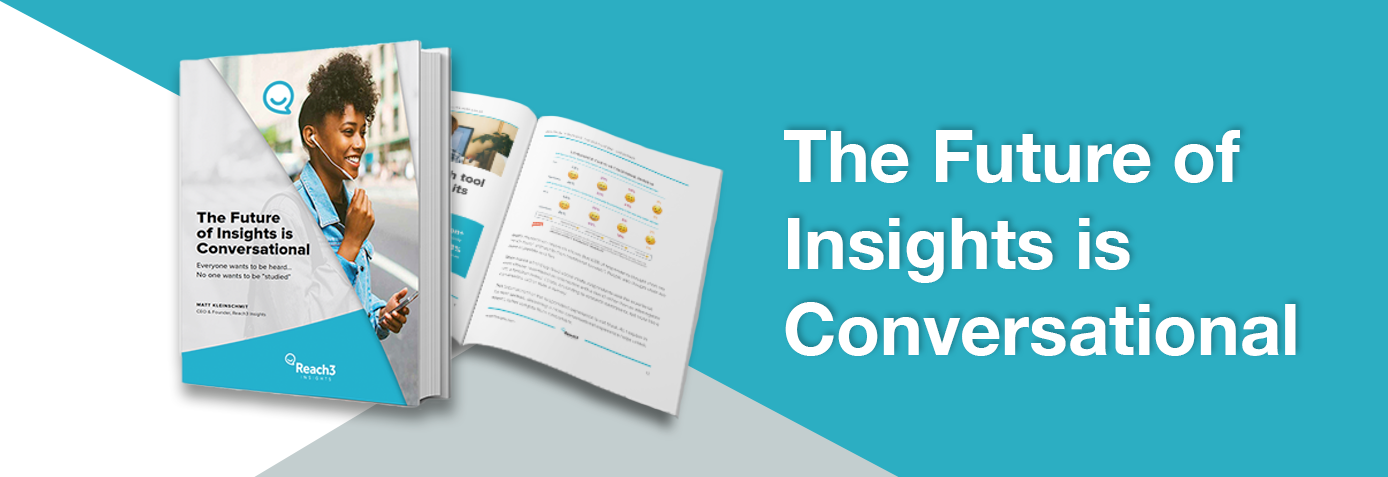Asking someone to do a survey shouldn’t feel like a trip to the dentist. But to change perceptions, modern insight professionals need to make research exercises more engaging, immersive and organic.
|
Note: This is the second article in a series of blog posts from our CEO & Founder, Matt Kleinschmit, exploring the principles of conversational research design. To get notified of new content from this series and for more best practices for market research and insight professionals, subscribe to our blog. |
In his 1986 movie, Back to School, Rodney Dangerfield makes a late-in-life journey to college—hoping to gain the degree he never earned as a young man. Soon—because he’s Rodney Dangerfield—he gets himself into trouble and, facing expulsion, is forced to do an impromptu examination. After answering 27 parts to one particularly tough question, he yells out: “That’s it! I can’t take it no more. I feel like I just gave birth … to an accountant!”

Tests are not fun, and definitely not funny (with all due respect to accountants). For those of us designing research methodologies for a living, the goal should be simple: Get consumers out of test-taking mode. We need to find engaging, immersive and organic ways of communicating with consumers if we are to have any hope of getting authentic feedback from them.
Sometimes, as the philosopher Marshall McLuhan famously said, the medium is the message: the form your research experiment takes will determine how it is perceived and treated.
At Reach3 Insights, we’ve built our research strategy around one simple idea: engage people in a conversational style—via the modern communications channels they use with friends and family members—and capture deeper, richer and more authentic insights that drive better business outcomes.
A good case-in-point is our recent work with a global consumer health company. The company had been doing traditional research with young mothers—one of the key target markets for their children’s pain-control product. They noticed that usage for the product was dropping off among kids after the age of two, and they needed to understand why.
The company had been using a traditional email-based methodology before coming to Reach3—a rear-view mirror approach that asked mothers to recall why they were buying certain products and not others. But after several traditional email surveys, the company said they were no further along in understanding the true reason behind the sales decline.
That shouldn’t come as any surprise. When you think about a traditional survey, it is often complex and intimidating—using multi-choice question grids and radio buttons, as well as overly formal and clinical language.
Think final-exam fun like “On a scale of one to 10, where one is this and 10 is that…”—a format that gets repeated over and over again.
But that’s not how we talk to each other in real life—certainly if we want an authentic and natural response. Just imagine what would happen if you did that with your spouse after a long day at work. “Honey, on a scale of one to 10, where one is terrible and 10 is terrific, how would you rate your day?” You might find yourself eating dinner alone. You certainly won’t get a lot of useful feedback.
For our consumer health client, we reimagined their research initiative to engage with mothers in a more conversational way. We knew from experience that young mothers were much more likely to treat email surveys as “work”—something that could be put off for later, after the kids had been picked up from daycare and the trip to the grocery store completed. That 25-minute traditional survey? It might get read a day later, a week later—or perhaps not at all.
Conversational research is different. Young mothers, like all of us, are more likely to check mobile messages while actively living their lives.
We are all looking for distractions in our daily routines—be it waiting at the daycare or in the grocery checkout line—and studies show that, when we respond to messages on our smartphones, we’re more likely to share our honest feelings. We engaged hundreds of these mothers in the moment—for a few minutes at a time—and used selfie-videos and instant-messaging conversational techniques to build engagement. And soon, the truth came out.
We discovered that moms weren’t buying the painkiller for their kids because of something quite simple: incomplete brand messaging. As the women explained, when young kids start to teethe, there’s a lot of pain associated with that—and a competing brand was explicitly promoting its effectiveness in combatting teething pain. Our client’s product, as good as it was, did not communicate that message. Given a choice between two painkillers, mothers switched to the brand promising a solution.
It was, in the end, an insight hiding in plain sight—but one that wasn’t picked up using a traditional email-based survey approach. “I had never thought of that before seeing the videos,” said our client. “It makes so much more sense now.” Sometimes the answer you’re looking for doesn’t require going back to school to do another test. Sometimes, it just requires putting down the book and joining the conversation.
If you’d like to learn more about using our conversational, mobile messaging-based approach to get authentic, stream-of-consciousness feedback from your customers, please reach out to our team.

Matt Kleinschmit
CEO and Founder, Reach3 Insights








.webp?width=65&height=83&name=A-LIGN_HIPAA%20(1).webp)

